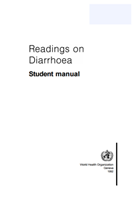Medical Education: Teaching Medical Students about Diarrhoeal Diseases
 World Health Organization 1992
World Health Organization 1992
http://apps.who.int/iris/handle/10665/40343
download  pdf
pdf
A collection of eight teaching units conveying essential information about the pathophysiology, clinical features, diagnosis, epidemiology, treatment and prevention of diarrhoea in children. Addressed to medical students undergoing clinical training in paediatrics, the manual aims to equip students with all the knowledge needed to assess patients, plan treatment, and prevent deaths through proper case management. Information, which is specific to conditions in developing countries, ranges from an explanation of the clinical features seen in different forms of dehydration, through advice on how to communicate with mothers, to a discussion of the role of feeding in the management of diarrhoea. Recommended lines of action draw their authority from published research and extensive WHO experience in programmes for the treatment and prevention of diarrhoea. The first two teaching units provide fundamental information about the epidemiology, clinical types of diarrhoea, causative agents, modes of transmission, pathophysiology, and implications for treatment. Subsequent units explain how the clinical assessment of patients should be performed and interpreted, discuss ways of teaching mothers to treat diarrhoea at home, describe clinical measures for the treatment of dehydrated patients, and discuss the special procedures to be followed during the treatment of dysentery, persistent diarrhoea, and diarrhoea associated with other illnesses. The remaining unis cover the nutritional management of diarrhoea in children, including those suffering from severe malnutrition, and explain how physicians can promote prevention, particularly through the education of mothers and other family members. Each unit concludes with a list of exercises for testing the knowledge acquired. Further practical information is presented in a series of annexes, which set out guidelines for determining whether a child is malnourished, list antimicrobial agents for the treatment of specific causes of diarrhoea, and provide illustrated, step-by-step instructions for intravenous rehydration and nasogastric rehydration
Preface
"Readings on Diarrhoea" is intended for medical students, especially
during their clinical training in pediatrics. It will also be useful for
physicians participating in training courses on the management of diarrhoea in
children. The materials in this book are compatible with other WHO publications
on the management and prevention of diarrhoea. Units that concern the management
of children with diarrhoea are based on the WHO treatment chart "Management of
the Patient with Diarrhoea" (1990). Portions of that chart are reproduced at
appropriate places in this text. "Readings on Diarrhoea" may be used as a source of practical
information and as a manual of treatment guidelines. It will be more effective,
however, if used in combination with organized teaching activities on diarrhoeal
diseases, such as lectures, discussions, demonstrations, and supervised practice
in treating cases. Readers are urged to check their understanding of the
material by answering the questions that follow each unit. A companion book
"References on Diarrhoea" contains related background articles that
summarize current research and provide additional information on most topics
covered in this text. This is made available to medical school libraries and
other institutions conducting training in diarrhoea case management. An
"Instructor's Manual" is available which provides guidance for medical
faculty and other teachers about how the material in each unit of the text may
be most effectively taught. There are eight units to the training program:
The complete set of these materials,
including tables and diagrams can be ordered from CDH.